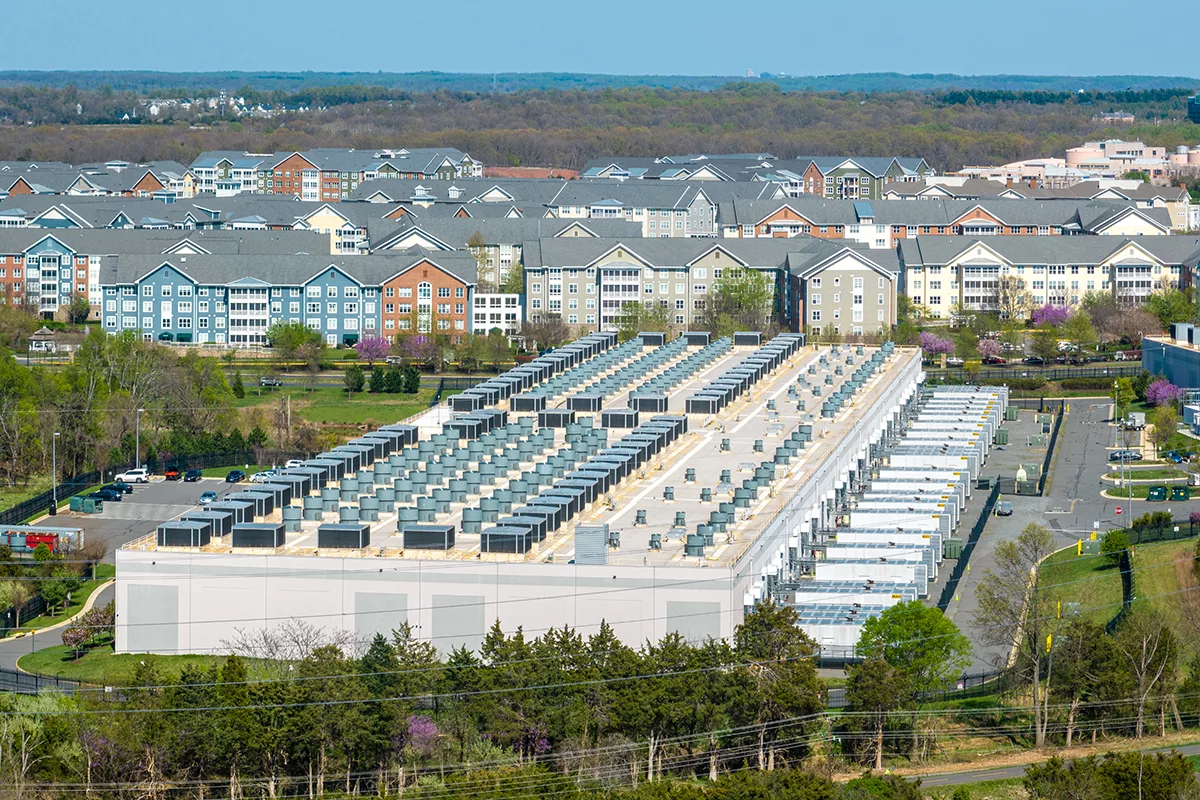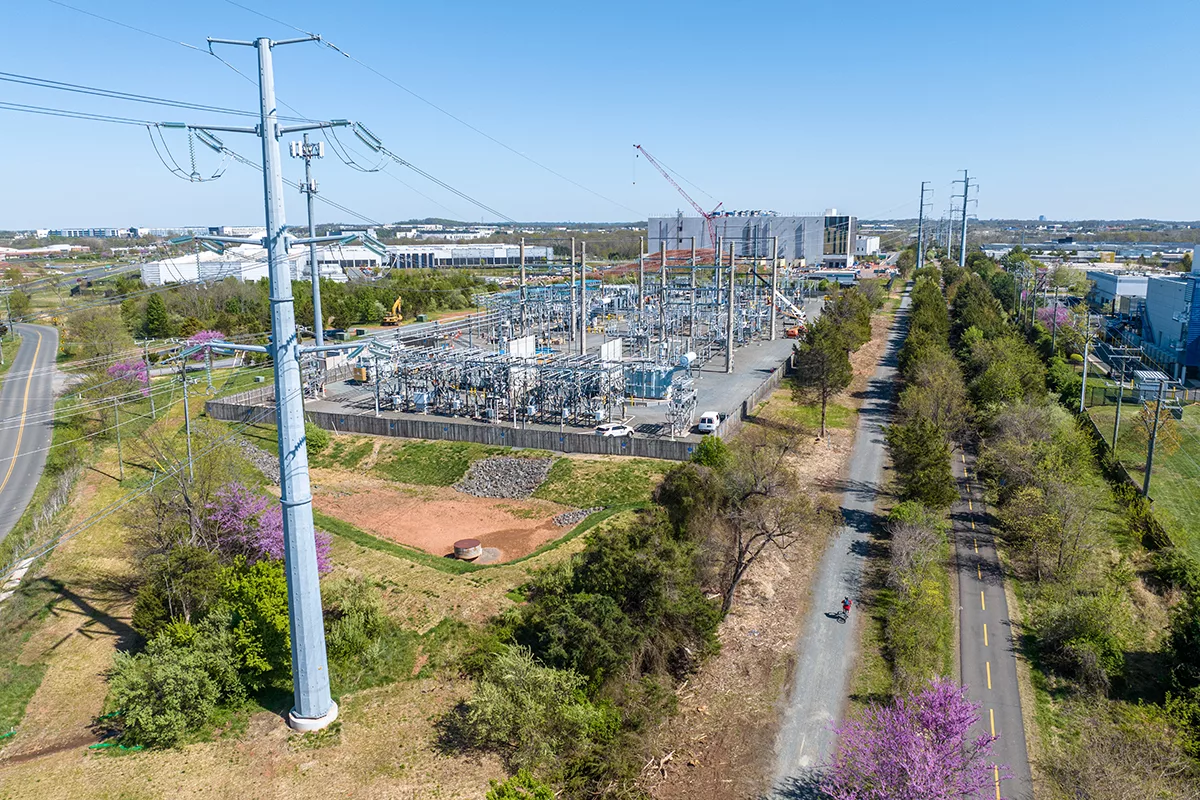When we search the internet, send an email, stream music, or use an “app” or social media, we’re working “in the cloud.” But where, and what, exactly, is this cloud? The metaphor has led to a lot of confusion and complacency that threatens the resources we depend upon.
In fact, much of “the cloud” is on the ground right here in Virginia. All the world’s on-demand computing takes place in colossal data center facilities, full of computer servers with very few people, that use massive amounts of electricity and water. The footprint of these facilities is growing globally, driven in part by today’s soaring demand for artificial intelligence, data harvesting, and cryptocurrency mining. And Virginia is subsidizing billions of dollars in data center development on the backs of its ratepayers, without a full understanding of the long-term ramifications.
The Commonwealth is already home to the largest and fastest-growing data center market in the world, housing nearly 50% of all U.S. facilities, and by some estimates, enabling up to 70% of the world’s internet activity. As of this printing, Loudoun boasts over 27 million square feet of data center space, and Prince William claims over 5 million square feet.
However, millions more square footage of data centers are either under construction or approved for development in both counties. The two largest data center campuses ever envisioned, a combined 22 million square feet of data center space, are proposed as part of the Prince William Digital Gateway project, in a rural part of Prince William County, next to Manassas National Battlefield Park. Large data center complexes are also proposed in King George, Stafford, Spotsylvania, Caroline, Culpeper, Orange and Surry counties.

This unchecked data center growth carries an insatiable demand for massive energy upgrades, extensive acreage, and tremendous water intake, jeopardizing the state’s efforts to meet its climate goals, improve air and water quality, advance land conservation and protect national and state parks.
Energy — Repeatedly, large transmission lines (not the smaller distribution lines usually seen in neighborhoods) have been built through communities, parks, and natural and cultural resources in order to get power to data centers. According to Dominion Energy, newer data center load requests range between 60-90 megawatts per building, which equates to the energy usage of more than 15,000 households at peak demand! These lines are NOT paid for by the data center developer. Rather, their costs are built into the energy tax bills paid by all Virginia ratepayers, and the utility can ask the state to approve eminent domain to route them through private property.
While residential energy demand in Virginia has remained flat, even in the midst of population growth, power demand for data centers has been increasing and currently makes up 21% of Dominion’s entire power load in Virginia. Dominion projects a five percent annual increase to its peak energy load — essentially doubling today’s energy demand in just 15 years — attributable almost entirely to data centers. This unheard-of increase will require billions of dollars for new high-voltage transmission lines, substations, and power generation facilities. If not for data centers, overall demand in the Commonwealth would be flat.
Water — Water consumption by data centers varies greatly depending on the type of cooling system used. Cooling systems that remove heat through water evaporation can be more energy efficient, but they shift impact to local water resources. A single data center can use between 1 million and 5 million gallons of water per day — as much as a town of 10,000 to 50,000 people! As the availability or cost of energy become more limiting, we are concerned the industry may increase its use of water-consumptive cooling systems that use less energy but more water overall.
Land — The buildout of data centers and accompanying energy infrastructure is already resulting in the conversion of thousands of acres of forests and farms to impervious pavement and buildings. For scale, the Prince William Digital Gateway, mentioned above, would allow 27 million square feet of data centers — the equivalent of about 150 Wal-Mart Supercenters — on 1,760 acres. All of this impervious surface reduces the region’s drought and flood resiliency and increases stormwater runoff, flooding, and pollution in our waterways.
Air Quality — Data centers often use commercial-sized, diesel-fueled backup power generators and large fuel storage tanks to ensure uninterrupted 24/7 service in the case of a power grid outage, adding yet another layer to its environmental threats. According to the Va. Department of Environmental Quality, Loudoun County data centers already have air permits for more than 4,000 backup diesel generators with a rated capacity of 11 gigawatts. For context, the North Anna nuclear power facility in Louisa County, which provides 17% of Virginia’s electricity, has a rated capacity of just 1.8 gigawatts. The data center development being envisioned would add hundreds more generators to Northern Virginia and rural communities where campuses are developed.
Diesel exhaust has well-documented health risks, especially for children, the elderly and those with existing health conditions like asthma and heart and lung disease. And of course, burning diesel emits greenhouse gasses, which contribute to regional ground-level ozone, acid rain, and global climate change. If the rapid pace of data center construction further strains Virginia’s power grid, use of backup generators will become more routine than emergency, putting air quality and public health at risk.

Fossil fuels — Dominion has claimed that the explosive energy demand from approved data centers is impossible to meet with renewable energy sources alone and that it cannot meet the requirements of the Virginia Clean Economy Act while maintaining reliability. To address the forecasted energy demand, Dominion’s Integrated Resource Plan (IRP) options include delaying the planned retirement of fossil fuel power sources, adding new natural gas power, and heavy reliance on purchasing out-of-state power (much of which is from heavily polluting sources), along with billions in spending for new transmission lines to move that power. While It also includes continued growth in renewable energy sources, these projects vary in siting and design and tend to be land-hungry. The IRP also puts a lot of faith in costly, unproven small modular nuclear sources becoming available in 10 years.
In a nutshell, Dominion is proposing that Virginia throw everything in the energy toolbox (and our pocketbooks) at this soaring demand and forfeit all progress on Virginia’s climate initiatives.
In response, PEC is working with local governments and residents in the Piedmont to improve local planning and zoning to protect communities, especially those most vulnerable to utility rate hikes, air pollution, and climate impacts, as well as our lands, waters and wildlife. We’ve formed a Virginia data center reform coalition to bring together local organizations with state and national partners, leading the charge on a legislative platform that quantifies the impacts of this data center buildout and shifts the cost burden away from Virginia ratepayers at large. This
eff ort includes a comprehensive study of the impacts to our natural resources and a framework to avoid and, when necessary, mitigate those impacts.
We ask all of our readers to join us in contacting elected officials in every corner of the state to demand better oversight of the data center industry and ensure costs are borne more fairly by the industry. It is critical that the state get a handle on this issue before it is too late.
This article appeared in the 2023 fall edition of The Piedmont Environmental Council’s member newsletter, The Piedmont View. If you’d like to become a PEC member or renew your membership, please visit pecva.org/join.
